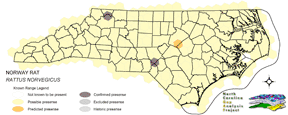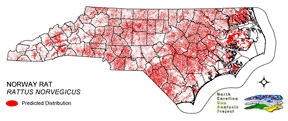
| Taxa: |
| Order: |
| Family: |
| Mammalia |
| Rodentia |
| Muridae |
| NatureServe Global Rank: |
| NatureServe State (NC) Rank: |
| G5 |
| SE |
| Federal Status: |
| NC State Status: |
| --- |
| --- |


| Land Unit |
| US Fish & Wildlife Service |
| US Forest Service |
| US National Park Service |
| US Department of Defense |
| NC State Parks |
| NC University System |
| NC Wildlife Res. Com. |
| NC Forest Service |
| NC Div. of Coastal Mgmt. |
| Local Governments |
| Non-Governmental Org. |
| Other Public Lands |
| Private Lands |
| GAP Status 1-2 |
| All Protected Lands |
| Statewide |
| Hectares |
| 6,731.10 |
| 12,951.54 |
| 15,717.42 |
| 3,745.89 |
| 1,563.30 |
| 1,216.62 |
| 4,961.61 |
| 976.65 |
| 34.74 |
| 670.50 |
| 1,648.62 |
| 2,462.85 |
| 3,931,260.39 |
| 16,486.62 |
| 51,332.73 |
| 3,983,941.23 |
| Acres |
| 16,632.91 |
| 32,003.95 |
| 38,838.58 |
| 9,256.29 |
| 3,863.00 |
| 3,006.33 |
| 12,260.40 |
| 2,689.87 |
| 85.84 |
| 1,656.84 |
| 4,073.83 |
| 6,085.83 |
| 9,714,354.09 |
| 41,015.83 |
| 127,122.42 |
| 9,844,807.77 |
| % of Dist. on |
| Prot. Lands |
| 13.1 % |
| 25.2 % |
| 30.5 % |
| 7.3 % |
| 3.0 % |
| 2.4 % |
| 8.7 % |
| 1.9 % |
| < 0.1 % |
| 3.0 % |
| 3.0 % |
| 3.6 % |
| < 0.1 % |
| 32.1 % |
| ----- |
| ----- |
| % of Dist. on |
| All Lands |
| 0.2 % |
| 0.3 % |
| 0.4 % |
| < 0.1 % |
| < 0.1 % |
| < 0.1 % |
| 0.1 % |
| < 0.1 % |
| < 0.1 % |
| < 0.1 % |
| < 0.1 % |
| < 0.1 % |
| 98.7 % |
| 0.4 % |
| ----- |
| ----- |
|
The Norway rat is believed to have been introduced to North America from Europe after its old world cousin, the black rat (Webster et al. 1985). However, the Norway rat has been more successful at colonizing the continent and now is found in most metropolitan areas. Like the black rat, the Norway rat is primarily found in human dominated landscapes but can also be found in rural settings (Webster et al. 1985). It is the scourge of inner city tenements and farm country grain houses alike (Whitaker and Hamilton 1998). It occupies buildings and subterranean infrastructure of inner cities as well as farmsteads, garbage dumps, and hedgerows and shrubby areas bordering grain fields of rural areas, and even salt marshes along the coast. Largest numbers occur wherever food is plentiful. To nest, the Norway rat will make use of secluded nooks or chambers in buildings or rubble piles, or will use another animal's burrow or dig their own (Whitaker and Hamilton 1998). NATURE SERVE GLOBAL HABITAT COMMENTS: Buildings and other structures in cities, villages, and farm country, also dumps and open areas near abundant food. Most common in colder climates of high latitudes; in warmer regions restricted to habitats highly modified by humans (Musser and Carleton, in Wilson and Reeder 1993). In Hawaii: locally common in some lowland cane fields, rare or absent in extensive grassland and most native forests (Tomich 1986). In Oklahoma, moved from fields to buildings in fall (Caire et al. 1989). Young are born in nests in buildings, under debris, or underground. |
| Code | Name | Description | NC Natural Heritage Program Equivalent |
| 180 | Agricultural Crop Fields | Farm fields used for row crops. | No equivalent |
| 205 | Agricultural Pasture/Hay and Natural Herbaceous | Farm fields used for pasture grass or hay production, as well as old fields dominated by native and exotic grasses. | No equivalent |
| 202 | Residential Urban | Includes vegetation interspersed in residential areas. Includes lawns, mixed species woodlots, and horticultural shrubs. Vegetation accounts for between 20 - 70% of the cover. | No equivalent |
| 203 | Urban Low-Intensity Developed | Highly developed areas with vegetation accounting for < 20% of the cover. | No equivalent |
| 204 | Urban High-Intensity Developed and Transportation Corridors | Highly developed areas including infrastructure such as roads, railroads. Vegetation represents < 20% of the cover. | No equivalent |
|
Wilson, D. E., and D. M. Reeder (editors). 1993. Mammal Species of the World:a Taxonomic and Geographic Reference. Second Edition. Smithsonian Institution Press, Washington, DC. xviii + 1206 pp.
Whitaker, J.O. Jr. and W.J. Hamilton, Jr. 1998. Mammals of the eastern United States. Cornell Univ. Press, Ithaca, New York. 583 pp. Glass, G. E., et al. 1989. Comparative ecology and social interactions of Norway rat (RATTUS NORVEGICUS) populations in Baltimore, Maryland. Occas. Pap. Mus. Nat. Hist. Univ. Kansas No. 130:1-33. Calhoun, J. B. 1962. The ecology and sociology of the Norway rat. U.S. Dept. of Health, Educ. and Welfare Publ. Health Serv. Publ. 1008. 288pp. Kramer, R. J. 1971. Hawaiian land mammals. Charles E. Tuttle Co., Rutland, Vermont, and Tokyo, Japan. Banfield, A.W.F. 1974. The mammals of Canada. University of Toronto Press, Toronto. Godin, A.J. 1977. Wild Mammals of New England. Johns Hopkins University Press, Baltimore. 304 pp. Hamilton, William J., Jr., and John O. Whitaker, Jr. 1979. Mammals of the eastern United States. Cornell Univ. Press, Ithaca, New York. 346 pp. Hall, E. R. 1981. The Mammals of North America. Second edition. 2 Volumes. John Wiley and Sons, New York, New York. Schwartz, Charles W., and Elizabeth R. Schwartz. 1981. The wild mammals of Missouri. University of Missouri Press, Columbia. 356 pp. Baker, Rollin H. 1983. Michigan mammals. Michigan State University Press. 642 pp. Webster, W. D., J. F. Parnell and W. C. Biggs Jr. 1985. Mammals of the Carolinas, Virginia, and Maryland. The University of North Carolina Press, Chapel Hill, NC. Tomich, P. Q. 1986. Mammals in Hawai'i. A synopsis and notational bibliography. Second edition. Bishop Museum Press, Honolulu. 375 pp. Caire, W., J. D. Tyler, B. P. Glass, and M. A. Mares. Z. Marsh (illustrator). 1989. Mammals of Oklahoma. University of Oklahoma Press, Norman. Oklahoma. 567 pp. Tomich, P. Q. 1970. Movement patterns of field rodents in Hawaii. Pacific Sci. 24:195-234. |
For more information please contact them at:
NC-GAP Analysis Project
Dept. of Zoology, NCSU
Campus Box 7617
Raleigh, NC 27695-7617
(919) 513-2853
www.basic.ncsu.edu/ncgap